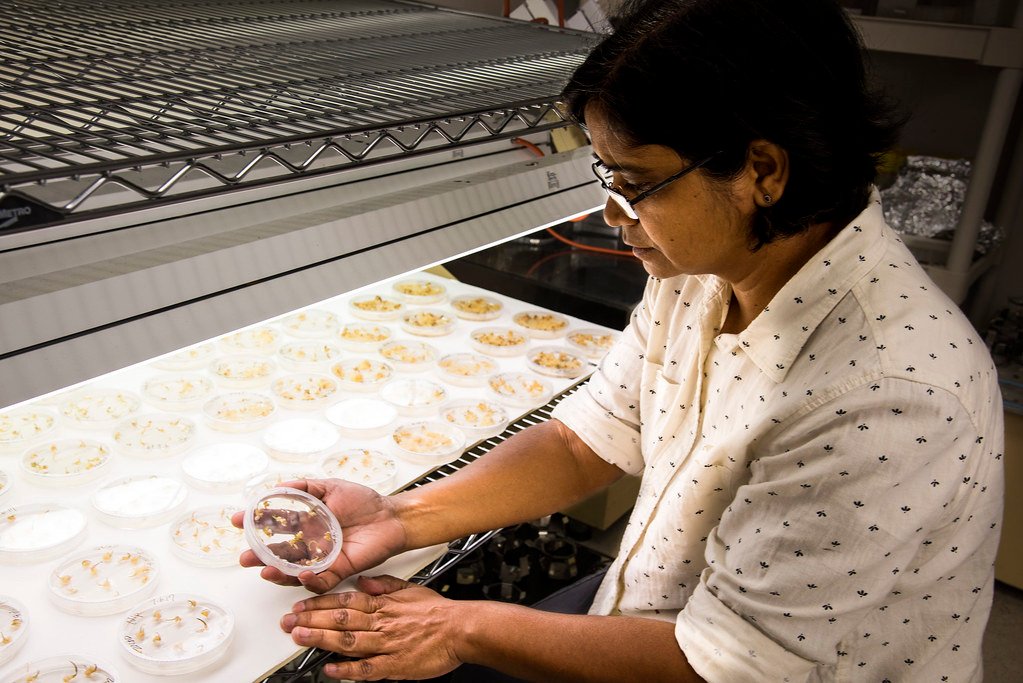Picture this: a farmer walks through rows of soybeans that can withstand drought better than their ancestors ever could. These aren’t your grandmother’s crops – they’re the result of precise molecular scissors that cut and paste DNA with surgical accuracy. While many people think gene editing is still science fiction, the reality is that this technology is already transforming American agriculture in ways that might surprise you. From the cornfields of Iowa to the mushroom farms of Pennsylvania, a quiet revolution is happening right under our noses.
The CRISPR Revolution Hits American Soil

Gene editing technology, particularly CRISPR-Cas9, has moved from laboratory benches to real farmland faster than most people realize. Unlike traditional genetic modification that involves inserting foreign genes, CRISPR works like a molecular word processor – it can delete, insert, or replace specific letters in a plant’s genetic code. This precision has made it possible for farmers to grow crops that are more nutritious, resistant to disease, and better adapted to changing climate conditions. The technology is so precise that scientists can make changes that would take decades to achieve through conventional breeding, and the results often can’t be distinguished from naturally occurring genetic variations.
Iowa’s Corn Revolution: Editing for Efficiency

Iowa leads the nation in corn production, so it makes sense that the state would be at the forefront of corn gene editing research and application. Farmers here are already growing gene-edited corn varieties that have been modified to resist certain herbicides more effectively than traditional varieties. These crops allow farmers to use more targeted weed control methods, reducing the overall amount of chemicals needed per acre. The University of Iowa has partnered with agricultural companies to develop corn varieties that can better utilize nitrogen from the soil, potentially reducing fertilizer requirements by up to 20%. Some Iowa farmers report that these gene-edited corn varieties have helped them maintain yields even during periods of unusual weather patterns.
California’s Leafy Green Laboratory

California’s massive agricultural industry has embraced gene editing technology across multiple crop types, with leafy greens leading the charge. Companies in the Central Valley are using CRISPR to develop lettuce varieties that stay fresh longer on store shelves and resist browning after harvest. These improvements aren’t just cosmetic – they significantly reduce food waste throughout the supply chain. Researchers at UC Davis have successfully created gene-edited spinach that contains higher levels of vitamin C and iron, addressing nutritional deficiencies that affect millions of Americans. The state’s year-round growing season makes it an ideal testing ground for new gene-edited varieties before they’re introduced to other regions.
Pennsylvania’s Mushroom Makeover

Pennsylvania might not be the first state you think of for agricultural innovation, but it’s home to some groundbreaking work in gene-edited mushrooms. The state produces about 60% of America’s mushrooms, and farmers here are using gene editing to create varieties that don’t brown as quickly when exposed to air. This simple change has massive implications for both farmers and consumers – mushrooms last longer, waste less, and maintain their appealing appearance throughout their shelf life. The Pennsylvania State University has been working with local mushroom producers to develop varieties that resist common fungal diseases, reducing the need for chemical treatments. These gene-edited mushrooms are already appearing in grocery stores across the Northeast, though most consumers don’t realize they’re eating the products of cutting-edge biotechnology.
North Dakota’s Soybean Success Story

North Dakota’s farmers have quietly become pioneers in gene-edited soybean production, with varieties that produce healthier oils for cooking and food processing. These soybeans have been modified to contain higher levels of oleic acid, which makes the oil more stable and reduces the need for harmful trans fats in food production. The state’s relatively isolated agricultural areas have made it an ideal location for field testing new gene-edited varieties without concerns about cross-contamination with conventional crops. North Dakota State University researchers have developed soybeans that can better tolerate the state’s short growing season and temperature fluctuations. Local farmers report that these gene-edited varieties have helped them maintain profitability even as traditional markets have become more competitive.
Florida’s Citrus Comeback

Florida’s citrus industry has been devastated by citrus greening disease, which has destroyed millions of trees and threatened the state’s iconic orange juice industry. Gene editing offers hope for this struggling sector, with researchers developing orange trees that can resist the bacterial infection that causes greening. The University of Florida has been working with local growers to test gene-edited citrus varieties that maintain the fruit’s traditional taste while providing disease resistance. Early trials show promising results, with some gene-edited trees showing complete resistance to citrus greening in controlled environments. While these varieties are still in testing phases, Florida farmers are optimistic that gene editing could save their industry from complete collapse. The economic impact could be enormous – Florida’s citrus industry contributes billions to the state’s economy and supports thousands of jobs.
The Science Behind the Scenes

Understanding how gene editing works helps explain why farmers are so excited about its potential. CRISPR technology uses a guide RNA to direct molecular scissors to specific locations in a plant’s DNA, where they can make precise cuts. Scientists can then either delete problematic genes, insert beneficial ones, or make tiny changes that improve plant characteristics. This process is much more precise than traditional genetic modification, which often involves inserting large chunks of foreign DNA. The beauty of CRISPR is that it can make changes that are identical to those that might occur naturally through mutation or traditional breeding, just much faster and with greater precision.
Regulatory Landscape: Navigating the Rules

The regulatory environment for gene-edited crops in the United States has been surprisingly accommodating compared to traditional GMOs. The USDA has determined that many gene-edited crops don’t require the same lengthy approval process as traditional genetically modified organisms, particularly when the changes could have occurred naturally. This streamlined approach has allowed farmers to access gene-edited varieties much more quickly than expected. However, the regulatory landscape varies significantly between states, with some imposing additional labeling requirements or restrictions. The FDA continues to evaluate gene-edited crops on a case-by-case basis, but has generally taken a science-based approach that focuses on the final product rather than the process used to create it.
Economic Impact: Following the Money

The economic implications of gene editing in agriculture are staggering, with early adopter states already seeing significant returns on their investments. Farmers using gene-edited crops report reduced input costs, higher yields, and improved crop quality that translates to better prices at market. The technology has attracted substantial investment from both private companies and public institutions, with billions of dollars flowing into research and development. States that have embraced gene editing early are positioning themselves as leaders in the next agricultural revolution, potentially attracting biotechnology companies and creating high-paying jobs. The cost savings from reduced pesticide use, improved crop resilience, and decreased food waste could benefit consumers through lower food prices and reduced environmental impact.
Environmental Benefits: A Greener Future

Gene editing offers significant environmental advantages that are already being realized on American farms. Crops that are naturally resistant to pests and diseases require fewer chemical treatments, reducing runoff into waterways and soil contamination. Gene-edited plants that use nitrogen more efficiently could dramatically reduce fertilizer requirements, addressing one of agriculture’s biggest environmental challenges. Some gene-edited crops are being developed to sequester more carbon in their roots, potentially turning farmland into carbon sinks that help combat climate change. The precision of gene editing also means that beneficial traits can be introduced without disrupting other plant characteristics, creating more sustainable agricultural systems.
Consumer Acceptance: Changing Minds

Public perception of gene editing has been surprisingly positive compared to earlier reactions to GMOs, partly because the technology is seen as more natural and precise. Many consumers don’t realize they’re already eating gene-edited foods, since these products often look and taste identical to conventional varieties. Education efforts by universities and agricultural organizations have helped people understand the difference between gene editing and traditional genetic modification. Surveys show that consumers are most accepting of gene-edited crops when the benefits are clearly explained, particularly improvements in nutrition, environmental impact, and food security. The success of early gene-edited products in the marketplace suggests that consumer acceptance will continue to grow as the technology proves its value.
Research Partnerships: Academia Meets Agriculture

The success of gene editing in these five states has been largely driven by strong partnerships between universities, government agencies, and private companies. Land-grant universities have played a crucial role in developing new varieties and testing them under real-world conditions. These partnerships have allowed for rapid translation of laboratory discoveries into practical applications for farmers. Federal funding through agencies like the USDA and NSF has supported much of the basic research that makes gene editing possible. The collaborative approach has also helped ensure that gene-edited crops are developed with farmer needs and consumer preferences in mind, rather than just focusing on technical possibilities.
Challenges and Obstacles: Not All Smooth Sailing

Despite the successes, gene editing in agriculture faces significant challenges that vary from state to state. Regulatory uncertainty continues to create hesitation among some farmers and investors, particularly for crops intended for export to countries with stricter GMO regulations. Technical challenges remain in editing certain plant species, and some desired traits are controlled by multiple genes that are difficult to modify simultaneously. Public relations challenges persist, with some consumer groups and environmental organizations remaining skeptical of any genetic modification technology. The high cost of developing gene-edited varieties can be prohibitive for smaller agricultural companies, potentially limiting innovation to large corporations.
International Competition: The Global Race

The United States faces increasing competition from other countries that are also investing heavily in agricultural gene editing technology. China has made massive investments in CRISPR research and is rapidly developing gene-edited crop varieties for its domestic market. European countries, despite stricter regulations, are conducting significant research that could eventually challenge American leadership in this field. The competitive landscape is driving increased investment and innovation in American gene editing programs, but also creating pressure to balance safety with speed to market. Trade implications are complex, as different countries have varying regulations for gene-edited crops, potentially creating barriers for American agricultural exports.
Future Varieties: What’s Coming Next

The pipeline of gene-edited crops being developed in these five states represents just the beginning of what’s possible with this technology. Researchers are working on wheat varieties that can grow in more marginal soils, potentially expanding farmable land in drought-prone regions. Gene-edited rice with enhanced nutritional content could address malnutrition in developing countries while creating new export opportunities for American farmers. Fruit trees that can better withstand extreme weather events are being developed to help orchards adapt to climate change. The next generation of gene-edited crops may include varieties that can fix their own nitrogen from the atmosphere, potentially revolutionizing fertilizer use in agriculture.
Training the Next Generation: Education and Workforce Development

Success in gene editing requires a skilled workforce that understands both traditional agriculture and cutting-edge biotechnology. Universities in these five states have expanded their agricultural programs to include gene editing techniques and biotechnology applications. Community colleges are developing programs to train technicians who can work with gene editing equipment and manage sophisticated agricultural systems. Extension programs are helping current farmers understand and adopt gene editing technologies on their operations. The integration of gene editing into agricultural education is creating new career opportunities that combine farming knowledge with high-tech skills, potentially attracting young people back to agriculture.
The Ripple Effect: Impact Beyond Agriculture

The success of gene editing in agriculture is creating ripple effects that extend far beyond farming communities. Rural economies in these states are benefiting from increased investment in biotechnology infrastructure and research facilities. The technology is spurring innovation in related fields, from food processing to environmental monitoring. Success stories from agricultural gene editing are helping to build public acceptance for medical applications of the same technology. The combination of traditional agricultural knowledge with cutting-edge biotechnology is creating a new model for rural economic development that other states are eager to replicate.
Gene editing technology has already moved from laboratory curiosity to practical agricultural tool across these five states, fundamentally changing how farmers think about crop improvement. The early successes in Iowa’s cornfields, California’s vegetable farms, Pennsylvania’s mushroom houses, North Dakota’s soybean fields, and Florida’s citrus groves demonstrate that this technology isn’t just promising – it’s delivering real results today. As these states continue to refine their approaches and develop new applications, they’re not just feeding America more efficiently; they’re writing the playbook for the future of global agriculture. The question isn’t whether gene editing will transform farming, but rather which states will lead the way in harnessing its full potential. What surprises you most about how quickly this technology has moved from science fiction to your dinner table?




